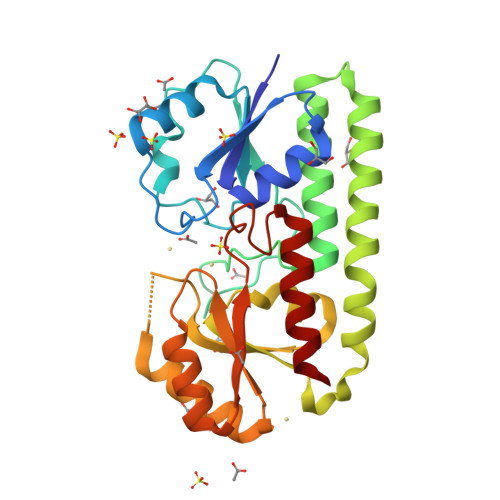Characterization of the heavy metal binding properties of periplasmic metal uptake protein CLas-ZnuA2.
Kumar, P., Dalal, V., Sharma, N., Kokane, S., Ghosh, D.K., Kumar, P., Sharma, A.K.(2020) Metallomics 12: 280-289
- PubMed: 31853532
- DOI: https://doi.org/10.1039/c9mt00200f
- Primary Citation of Related Structures:
6IXI - PubMed Abstract:
Candidatus Liberibacter asiaticus (CLas), a phloem-limited unculturable Gram-negative bacterium, causes citrus greening disease. The proteome analysis of CLas showed the presence of a heavy metal permease and Co/Zn/Cd cation exporter system. However, there is no designated metal uptake protein specific for the heavy metal permease in CLas. One of the metal uptake proteins, designated as CLas-ZnuA2, in our previous studies, showed a lower metal-binding affinity for Mn2+ and Zn2+ and was postulated to bind and transport metals rather non-specifically. The present study focused on the characterization of the heavy metal binding properties of CLas-ZnuA2 using SPR, CD, DSC and crystallographic studies. The crystal structure analysis of Cd2+ bound CLas-ZnuA2 showed octahedral geometry for Cd2+ binding as compared to a non-preferred square-pyramidal geometry for Mn2+ and Zn2+ binding in earlier reported crystal structures. In SPR analysis, the binding affinities of 4.7 × 10-6 M, 7.2 × 10-6 M, 5.3 × 10-5 M and 4.3 × 10-5 M for Hg2+, Cd2+, Ba2+ and Co2+ respectively were higher as compared to earlier reported values for Mn2+ and Zn2+. Likewise, CD and DSC analysis showed relatively higher thermal stability for CLas-ZnuA2 on heavy metal binding. Taken together with the expression of the permease and exporter system for heavy metals, our results indicate that CLas-ZnuA2 may be involved in sequestering and transport of various transition divalent metals in environmentally stressed conditions.
Organizational Affiliation:
Department of Biotechnology, Indian Institute of Technology Roorkee, Roorkee-247 667, India. aksbsfbs@yahoo.co.in aksbsfbs@iitr.ac.in.






















